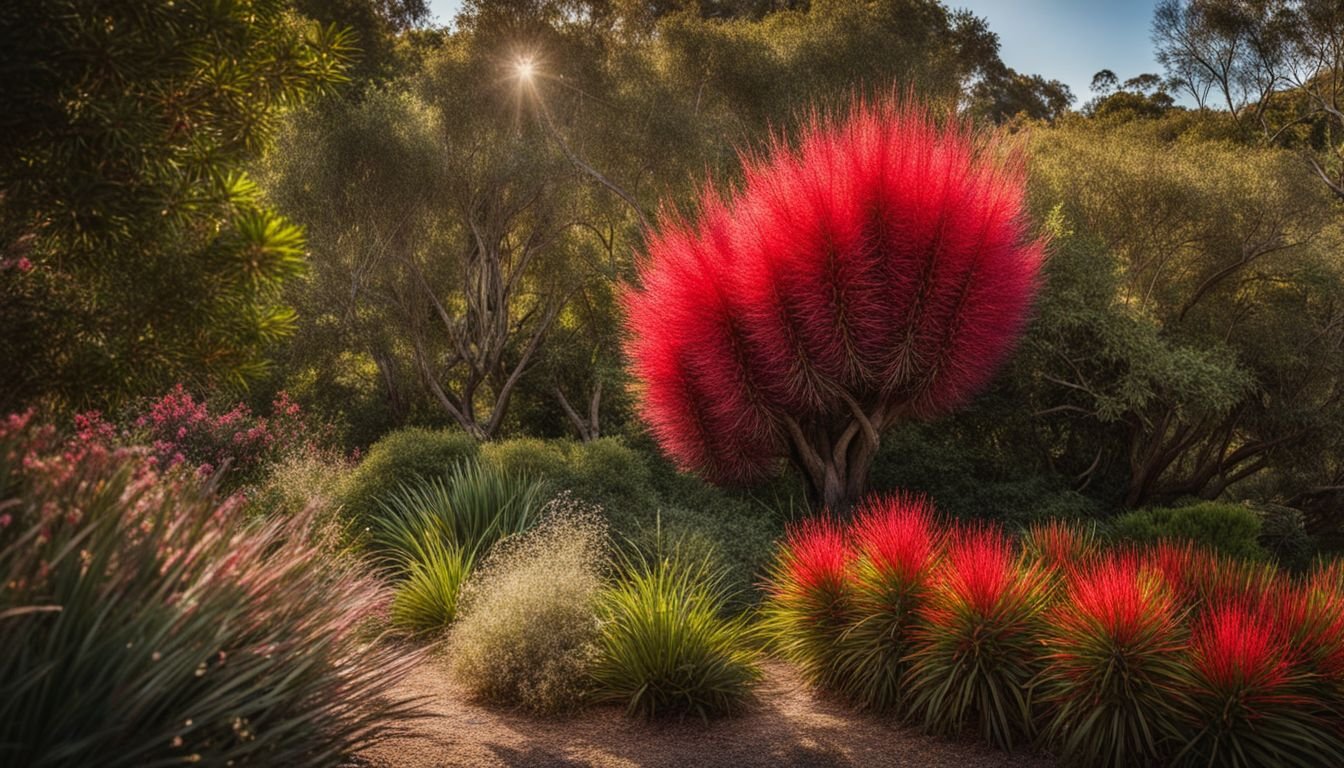Gardening in the Aussie heat can be tough, especially for your beloved plants. The bottlebrush tree, or Callistemon, thrives in our sunburnt country’s challenging climate. This article will guide you through growing and nurturing these vibrant trees to ensure they flourish in your garden.
Read on for essential tips that bring a burst of colour to your backyard!
Key Takeaways
- Bottlebrush trees, known as Callistemon, are perfect for Australian climates because they enjoy the sun and can handle drought.
- To grow your own bottlebrush tree you can use cuttings, seeds or air layering. Remember to keep soil moist while it’s taking root.
- Pruning is key after the first flowers bloom in spring—it encourages new growth and more flowers. Always use clean tools when cutting.
- Watch out for pests like spider mites and practice good drainage to prevent root rot. You might need extra water during long dry spells.
- These natives not only add beauty with their colorful flowers but they also bring birds into your garden who love the nectar.
Understanding the Bottlebrush Tree

Dive into the vibrant world of the Bottlebrush Tree, a quintessential Australian native that’s as remarkable in variety as it is in resilience. From the striking flower spikes that attract nectar-loving birds to its adaptability across diverse climates, this ornamental plant holds secrets just waiting to be explored by green thumbs and nature enthusiasts alike.
Occurrence and Varieties of Bottlebrush
Bottlebrush plants, or Callistemon, thrive across Australia, revealing their splendor in gardens and natural settings alike. These hardy shrubs favor the country’s diverse climates, often basking in full sun and displaying resilience to drought conditions.
Garden enthusiasts frequently choose these native plants for their striking floral displays and ability to attract nectar-loving birds into their yards.
Varieties of Callistemon are plentiful, each with distinctive traits sure to appeal to any plant lover’s tastes. Consider the vibrant crimson bottlebrush (Callistemon citrinus), with its bright red flower spikes that evoke a brush used for cleaning bottles – it’s no wonder where the common name comes from! Other types include the weeping bottlebrush (Callistemon viminalis) known for its graceful drooping branches and pink-tinted varieties that add a softer touch to your garden display.
Whether used as ornamental shrubs or shaped into hedges, these plants embody versatility and aesthetic charm in abundance.
Bottlebrush Flowers, Fruits, and Leaves
Bottlebrush trees burst into colour with their vibrant, brush-like flowers that charm nectar-loving birds and delight garden enthusiasts. These iconic flowers of the Callistemon species range from fiery reds to soft pinks and radiant purples, adding a spectacular display to any Australian native plant project.
Not only do they offer visual splendour, but after the blooms have shown off their beauty, they give way to woody fruits. Clinging tightly along the stem, these capsules safeguard seeds until conditions are right for them to be sown into new growth.
Leaves on bottlebrush plants vary from one cultivar to another but commonly share a hardy resilience suitable for diverse Aussie climates. They can withstand long dry spells as these drought-resistant marvels store moisture within their narrow or lance-shaped foliage.
Whether you cultivate the popular Callistemon citrinus or the weeping form of Callistemon viminalis, expect bright green leaves that may exhibit hints of silver or bronze as an alluring backdrop for flowering spectacles.
Gardening fans appreciate this versatile foliage for its essential oils too, which release a refreshing fragrance when crushed between fingers—a unique feature among garden plants.
Cultivation of Bottlebrush Trees

Mastering the cultivation of bottlebrush trees can transform your garden into an Australian native paradise, attracting a chorus of nectar-loving birds with fiery red blooms. Embrace the simple elegance that comes from understanding propagation techniques and pruning practices tailored specifically for these resilient small trees.
Propagation Techniques
Propagation techniques for bottlebrush trees are vital for successful growth. These methods can ensure strong, healthy plants that thrive in your Australian garden.
- Cuttings: This is a widely used technique and it’s quite effective. Take semi-hardwood cuttings from the callistemon during warmer months. Remove the lower leaves and dip the base into rooting hormone before planting them in a moist propagation mix. Keep them in a warm place with indirect sunlight until roots develop.
- Seed Propagation: Collect seeds from the mature capsules after flowering has ended, or purchase them from a reputable plants nursery. Sow the seeds thinly over a tray filled with a well-drained seed-raising mix. Lightly cover with more mix or fine gravel and keep moist until germination occurs.
- Air Layering: Select a healthy branch and make an upward-cutting incision below a leaf node. Insert a small piece of wood to keep the wound open, then wrap it with damp sphagnum moss and secure it with plastic film to retain moisture. Roots should form within a few months, after which you can sever the new plant from the parent tree.
Pruning Practices
Successfully propagating your bottlebrush tree leads to the next vital step: pruning. Established bottlebrush trees benefit greatly from regular trimming to promote lush growth and vibrant blooms.
- Begin pruning in late spring after the first flowering cycle to encourage a second bloom. Cut just above the leaf joints on the stalk where flowers have faded.
- Target any dead, damaged, or diseased branches first for removal. These can hinder the plant’s overall health and prevent it from thriving.
- Shape your bottlebrush tree while maintaining its natural form. Avoid over – pruning, as this can stress the tree and reduce flowering.
- Use clean, sharp tools for every cut to minimise damage and reduce the risk of disease transmission between plants.
- Prune younger trees lightly to establish their shape and ensure a strong foundation for future growth. This helps develop a more compact form as recommended.
- Thinning out dense areas improves air circulation within the canopy, which is crucial in preventing fungal diseases.
- Regularly remove suckers from the base of the tree, as they can sap energy away from the main structure and growth points.
- Implement periodic mulching after pruning to conserve moisture and provide nutrients for recovery and new development.
Common Problems and Solutions for Bottlebrush Trees
Bottlebrush trees often struggle with root rot if they sit in waterlogged soil. To prevent this, ensure good drainage by mixing in sand or organic matter before planting and avoid overwatering.
Opt for a raised bed or mound planting if your area is prone to heavy rains. During dry spells, though, keep an eye on moisture levels as Bottlebrushes are drought tolerant but will still need watering during extended periods without rain.
Pests can also be a headache for the bottlebrush grower. If you notice leaves being eaten or webbing between branches, it may be spider mites or other common garden pests at work. A blast of water from the garden hose can dislodge many unwanted visitors while encouraging natural predators like ladybirds to settle in your garden helps keep pests at bay naturally.
When pruning, always use sharp tools to make clean cuts; this not only encourages new growth but also reduces the risk of disease entering through jagged wounds on the branches.
Conclusion
As you dive into the world of Bottlebrush trees, embrace their vibrant presence in your Australian garden. Keep their striking flowers flourishing and watch as nectar-loving birds become regular visitors.
Remember, these hardy natives thrive with a bit of care and can withstand tough weather conditions. Cultivating Callistemons rewards gardeners with stunning visuals and a hearty nod to Australia’s botanical wonders.
May your gardening efforts bloom like the spectacular hues of these cherished plants.
For more detailed insights on challenges you might face with your bottlebrush trees, check out our comprehensive guide on common bottle brush tree problems and solutions.
FAQs
1. How do I grow a bottle brush tree in Australia?
To grow a bottle brush tree, or Callistemon, choose a sunny spot and plant it in well-draining soil. These Australian native plants are perennial and tough, often frost tolerant and perfect for attracting nectar loving birds.
2. Can you tell me if bottle brush trees need lots of water?
Bottle brush trees, including cultivars like Callistemon citrinus and Callistemon viminalis, don’t require much water once established; they’re quite drought-resistant. Water them regularly during their first growing season to help them settle in.
3. Is pruning necessary for maintaining my bottle brush tree?
Yes, pruning your bottle brush tree keeps it healthy and looking good. You can prune after flowering to maintain shape and encourage bushier growth.
4. Do different types of bottle brush trees cross-breed easily?
Indeed, the various species within the Callistemon group hybridise readily when grown together, which allows gardeners to enjoy a wide array of hybrids with diverse features such as color variation among flowers.
